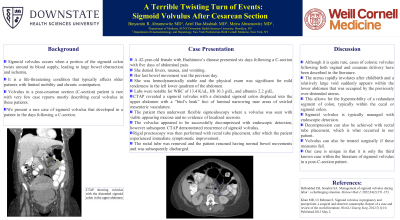Tuesday Poster Session
Category: Colon
P3784 - A Terrible Twisting Turn of Events: Sigmoid Volvulus After Cesarean Section
Tuesday, October 29, 2024
10:30 AM - 4:00 PM ET
Location: Exhibit Hall E

Has Audio
- BA
Binyamin R. Abramowitz, MD
SUNY Downstate Health Sciences University
New York, NY
Presenting Author(s)
Binyamin R. Abramowitz, MD1, Ariel Bar-Mashiah, MD2, Meira Abramowitz, MD3
1SUNY Downstate Health Sciences University, New York, NY; 2New York-Presbyterian Hospital/Weill Cornell Medical Center, New York, NY; 3New York-Presbyterian / Weill Cornell Medical Center, New York, NY
Introduction: Sigmoid volvulus occurs when a portion of the sigmoid colon twists around its blood supply, leading to large bowel obstruction and ischemia. It is a life-threatening condition that typically affects older patients with limited mobility and chronic constipation. Volvulus in a post-cesarean section (C-section) patient is rare with very few case reports mostly describing cecal volvulus in these patients. We present a rare case of sigmoid volvulus that developed in a patient in the days following a C-section.
Case Description/Methods: A 42-year-old female with Hashimoto’s disease presented six days following a C-section with five days of abdominal pain. She denied fevers, nausea, and vomiting. Her last bowel movement was the previous day. She was hemodynamically stable and the physical exam was significant for mild tenderness in the left lower quadrant of the abdomen. Labs were notable for WBC of 13.4 K/uL, Hb 10.3 g/dL, and albumin 2.2 g/dL. Computer tomography of the abdomen and pelvis (CTAP) revealed a sigmoid volvulus with a distended sigmoid colon displaced into the upper abdomen with a “bird’s beak” foci of luminal narrowing near areas of swirled mesenteric vasculature. The patient then underwent flexible sigmoidoscopy where a volvulus was seen with viable appearing mucosa and no evidence of localized necrosis. The volvulus appeared to be successfully decompressed with endoscopic detorsion, however subsequent CTAP demonstrated recurrence of sigmoid volvulus. Rigid proctoscopy was then performed with rectal tube placement, after which the patient experienced immediate symptomatic improvement. The rectal tube was removed and the patient resumed having normal bowel movements and was subsequently discharged.
Discussion: Although it is quite rare, cases of colonic volvulus following both vaginal and cesarean delivery have been described in the literature. The uterus rapidly involutes after childbirth and a relatively large void suddenly appears within the lower abdomen that was occupied by the previously over-distended uterus. This allows for the hypermobility of a redundant segment of colon; typically within the cecal or sigmoid colon. Sigmoid volvulus is typically managed with endoscopic detorsion, decompression can also be achieved with rectal tube placement, which is what occurred in our patient. Volvulus can also be treated surgically if these measures fail. Our case is unique in that it is only the third known case within the literature of sigmoid volvulus in a post-C-section patient.
Disclosures:
Binyamin R. Abramowitz, MD1, Ariel Bar-Mashiah, MD2, Meira Abramowitz, MD3. P3784 - A Terrible Twisting Turn of Events: Sigmoid Volvulus After Cesarean Section, ACG 2024 Annual Scientific Meeting Abstracts. Philadelphia, PA: American College of Gastroenterology.
1SUNY Downstate Health Sciences University, New York, NY; 2New York-Presbyterian Hospital/Weill Cornell Medical Center, New York, NY; 3New York-Presbyterian / Weill Cornell Medical Center, New York, NY
Introduction: Sigmoid volvulus occurs when a portion of the sigmoid colon twists around its blood supply, leading to large bowel obstruction and ischemia. It is a life-threatening condition that typically affects older patients with limited mobility and chronic constipation. Volvulus in a post-cesarean section (C-section) patient is rare with very few case reports mostly describing cecal volvulus in these patients. We present a rare case of sigmoid volvulus that developed in a patient in the days following a C-section.
Case Description/Methods: A 42-year-old female with Hashimoto’s disease presented six days following a C-section with five days of abdominal pain. She denied fevers, nausea, and vomiting. Her last bowel movement was the previous day. She was hemodynamically stable and the physical exam was significant for mild tenderness in the left lower quadrant of the abdomen. Labs were notable for WBC of 13.4 K/uL, Hb 10.3 g/dL, and albumin 2.2 g/dL. Computer tomography of the abdomen and pelvis (CTAP) revealed a sigmoid volvulus with a distended sigmoid colon displaced into the upper abdomen with a “bird’s beak” foci of luminal narrowing near areas of swirled mesenteric vasculature. The patient then underwent flexible sigmoidoscopy where a volvulus was seen with viable appearing mucosa and no evidence of localized necrosis. The volvulus appeared to be successfully decompressed with endoscopic detorsion, however subsequent CTAP demonstrated recurrence of sigmoid volvulus. Rigid proctoscopy was then performed with rectal tube placement, after which the patient experienced immediate symptomatic improvement. The rectal tube was removed and the patient resumed having normal bowel movements and was subsequently discharged.
Discussion: Although it is quite rare, cases of colonic volvulus following both vaginal and cesarean delivery have been described in the literature. The uterus rapidly involutes after childbirth and a relatively large void suddenly appears within the lower abdomen that was occupied by the previously over-distended uterus. This allows for the hypermobility of a redundant segment of colon; typically within the cecal or sigmoid colon. Sigmoid volvulus is typically managed with endoscopic detorsion, decompression can also be achieved with rectal tube placement, which is what occurred in our patient. Volvulus can also be treated surgically if these measures fail. Our case is unique in that it is only the third known case within the literature of sigmoid volvulus in a post-C-section patient.
Disclosures:
Binyamin Abramowitz indicated no relevant financial relationships.
Ariel Bar-Mashiah indicated no relevant financial relationships.
Meira Abramowitz indicated no relevant financial relationships.
Binyamin R. Abramowitz, MD1, Ariel Bar-Mashiah, MD2, Meira Abramowitz, MD3. P3784 - A Terrible Twisting Turn of Events: Sigmoid Volvulus After Cesarean Section, ACG 2024 Annual Scientific Meeting Abstracts. Philadelphia, PA: American College of Gastroenterology.
